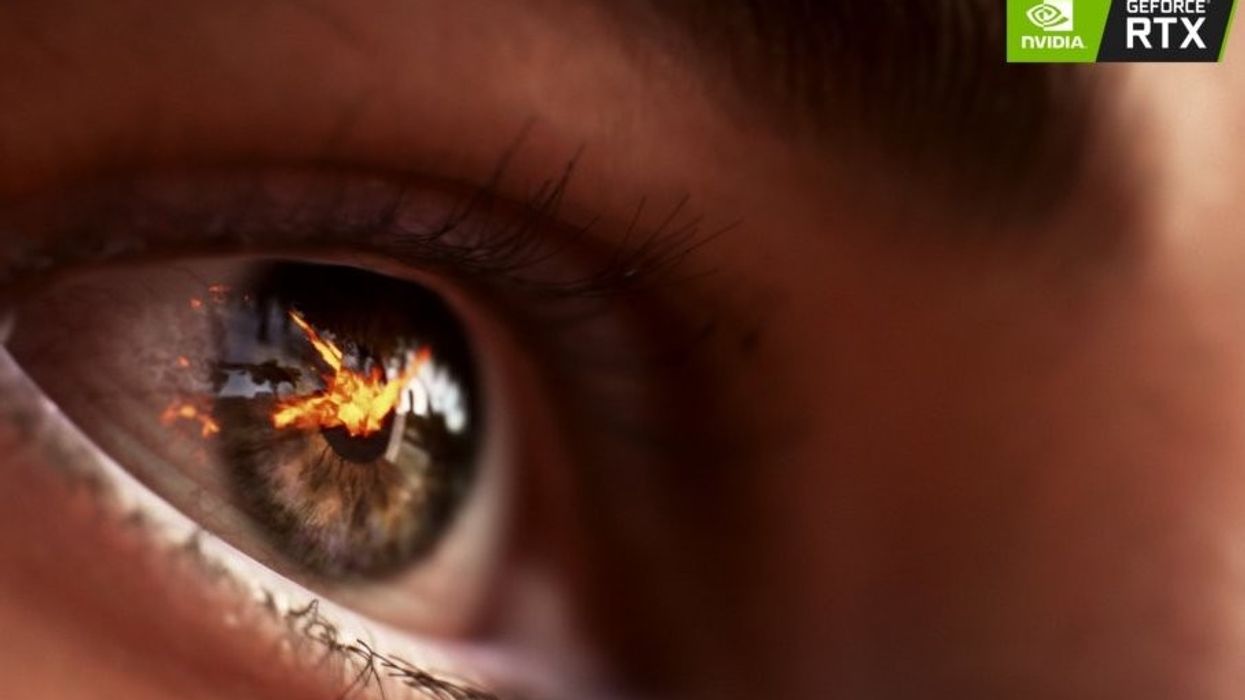NVIDIA is Opening up Ray Tracing to Millions of Content Creators
NVIDIA's RTX video card offers AI-driven ray tracing to the rest of us.

SIGGRAPH has to be the nerdiest trade show you'll ever attend. We're talking about inside as the term "inside baseball" gets, with tons of geeks talking about nodes and stuff. It can get a bit dry unless you're into that sort of thing, but when NVIDIA announced that it was bringing their groundbreaking AI-driven feature to the rest of us, a year after lighting up the worlds of scientific visualization, pro-level visual effects, gaming, and architecture, well...that's something that gets people's attention.
Why low-budget filmmakers should care
But for the rest of us, ray tracing in visual effects from even Adobe After Effects or AutoDesk Flame would get bogged down due to the computationally demanding interactive workflow that ray tracing demands.
If you were a filmmaker on a budget, and couldn't afford thousands for a new video card, this meant that you would have to wait until NVIDIA fine-tuned the algorithms to better support mid to lower-end RTX lines. And NVIDIA said that it would be coming. The hardware came out first, and now you can get an RTX card for under $800. Now, the software is opening up ray tracing to over 40 different applications running RTX video cards.
Here's what Greg Estes, NVIDIA's Vice President of Corporate Marketing has to say about all this:
“Around the world, designers and artists, OEMs and software providers have embraced real-time ray tracing and AI acceleration as the new industry standard in product design and content creation. From RTX Studio laptops used by millions of creatives to data centers managed by global businesses, the power of NVIDIA RTX can be accessed from anywhere to design better products and produce richer, more immersive entertainment faster than ever.”
Hold on...what can ray tracing do for my VFX workflow?
Okay, before we move further, maybe we should review what ray tracing can do for a visual effect. Ray tracing through RTX allows designers to see how lighting, shadows and reflections interact in the virtual space, enabling them to create more accurate 3D textures and environments. It can calculate the position of the light, down to the photon level, as that light interacts and bounces off materials and surfaces. It's like having a virtual mirrored sphere that is always there giving you accurate readings as you adjust your virtual scene. With that kind of accuracy, visual effects enjoy a new level of realistic interaction, especially at 4K and above. This results in more lifelike images than traditional visual effects platforms can perform outside of the RTX platform.
- Adobe Substance Painter: RTX ray tracing accelerates baking performance up to 192x faster than CPUs.
- Autodesk Flame: RTX Tensor Cores dramatically accelerate the new machine learning feature set of Autodesk Flame v2020.1. The built-in machine learning analysis algorithms help artists isolate, extract and modify common objects in moving footage, dramatically accelerating visual effects and compositing workflows.
- Blender Cycles: NVIDIA OptiX™ 7 with CUDA® dramatically accelerates performance of open source renderer.
- Dimension 5 D5 Fusion: RTX ray tracing via UE4’s implementation of DXR allows architects and designers to quickly simulate ground truth lighting and shadows.
- Daz 3D Daz Studio: NVIDIA Iray® allows creators to assemble scenes with interactive RTX accelerated ray tracing to quickly build their artistic composition and render out in full fidelity.
- Foundry MODO: RTX performance through OptiX in the completely redesigned MODO path-traced renderer offers a significant performance boost over CPU rendering.
- Luxion KeyShot: RTX accelerated ray tracing and AI denoising for photorealistic visualization of 3D data for product design reviews, marketing, animations, illustrations and more via OptiX support in KeyShot 9.
Adobe's Vice President of 3D and Immersive, Sébastien Deguy, says:
"We believe NVIDIA RTX ray tracing performance is a game-changer, significantly reducing the time for baking, so artists can quickly iterate between modeling and painting, and bring better designs to life faster.”
That brings a total of 40 applications that support ray tracing, and by year's end, every single 3D design application in the business has committed to supporting RTX and ray tracing. On top of that, every OEM manufacturer is making RTX a standard that creatives will be able to enjoy with new video cards, laptops, and more. Over 27 purpose-built laptops and workstations, including 10 that NVIDIA is featuring from workstations from Dell, HP, Lenovo and BOXX, are hitting the market.
To learn more about how RTX and ray tracing can up your game in your visual effects and virtual reality workflow, visit NVIDIA's website, or if you're at SIGGRAPH, swing by NVIDIA's booths (#1303 and 1313) for a hands-on demonstration.













